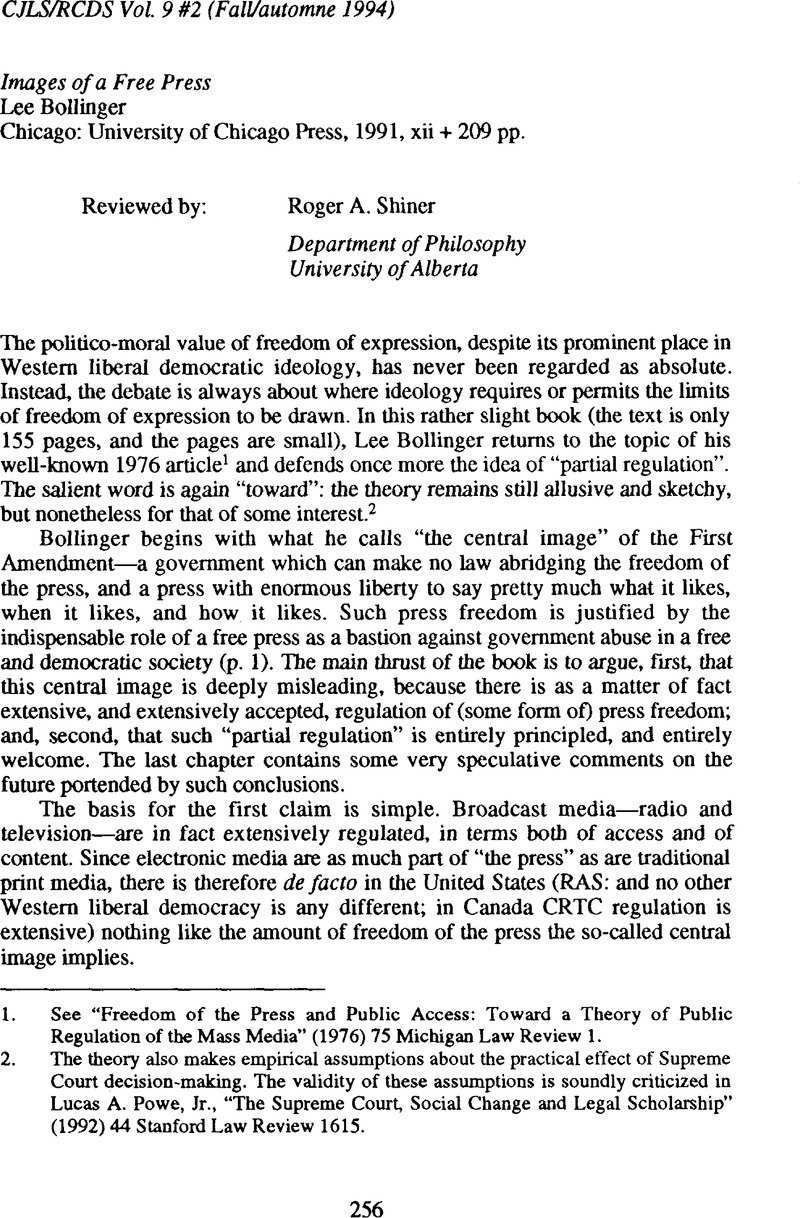No CrossRef data available.
Article contents
Images of a Free Press, Lee Bollinger, Chicago: University of Chicago Press, 1991, xii + 209 pp.
Published online by Cambridge University Press: 18 July 2014
Abstract

- Type
- Reviews/Recensions
- Information
- Canadian Journal of Law and Society / La Revue Canadienne Droit et Société , Volume 9 , Issue 2 , Fall/automne 1994 , pp. 256 - 260
- Copyright
- Copyright © Canadian Law and Society Association 1994
References
1. See “Freedom of the Press and Public Access: Toward a Theory of Public Regulation of the Mass Media” (1976) 75 Michigan Law Review 1CrossRefGoogle Scholar.
2. The theory also makes empirical assumptions about the practical effect of Supreme Court decision-making. The validity of these assumptions is soundly criticized in Powe, Lucas A. Jr., “The Supreme Court, Social Change and Legal Scholarship” (1992) 44 Stanford Law Review 1615CrossRefGoogle Scholar.
3. Cf., e.g., Powe, Lucas A. Jr., American Broadcasting and the First Amendment (Berkeley: University of California Press, 1987)Google Scholar.
4. As it has been succinctly put: “The problem … is figuring out how fairness became either a First Amendment value or a limitation on the First Amendment… We can have a free press or a fair one, but… we cannot have both”. Powe, Lucas A. Jr., The Fourth Estate and the Constitution (Berkeley: University of California Press, 1991) at 278–79Google Scholar.
5. For detailed discussion of the general tensions within the image, see Cole, David, “Agon at Agora: Creative Misreadings in the First Amendment Tradition” (1986) 95 Yale Law Journal 857CrossRefGoogle Scholar, and for the specific tensions within Canadian constitutional jurisprudence, see Weinrib, Lorraine E., “Does Money Talk? Commercial Expression in the Canadian Constitutional Context” in Schneiderman, David, ed., Freedom of Expression and the Charter (Toronto: Thomson Professional Publishing, 1991) 336 at 340ff.Google Scholar
6. Given that power is of concern to Bollinger, I find it remarkable that there is not one word in the book about First National Bank v. Bellotti 435 U.S. 765 (1978), the case in which the U.S. Supreme Court struck down a statute limiting the amount of money corporations could spend on political advocacy. If ever there is a case of unequal bargaining power in the market-place of ideas, it is here.
7. In the area of commercial expression, this “made in Canada” approach has not so far existed—see Shiner, Roger A., “Freedom of Commercial Expression” in Waluchow, Wilfrid J., ed., Free Expression: Essays in Law and Philosophy (Oxford: Clarendon Press, 1994) 91Google Scholar.




